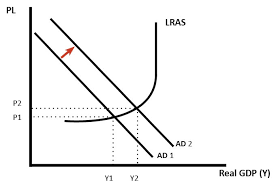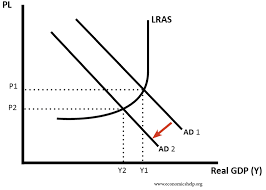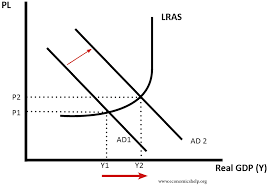
Ch 17 - Demand Management (demand-side policies)
Fiscal policy: involves the government changing the levels of taxations and government spending in order to influence aggregate demand and the level of economic activity
AD is the total level of planned expenditure in an economy
Purpose of Fiscal policy:
Stimulate economic growth during a period of recession
Keep inflation low
Stabilise economic growth
Often simultaneously used monetary policy
Governments prefer using monetary policy to stabilise the economy
Fiscal policy depends on size of multiplier
Expansionary fiscal policy:
Involves increasing AD
Government will increase spending and cut taxes
Lower taxes increase government spending → more disposable income
Will worsen the government budget, governments will need to increase borrowing

Deflationary Fiscal policy:
Decreasing AD
Governments will cut government spending and increase taxes
Higher taxes → reduce consumer spending
Improves government budget deficit

Fine tuning: maintaining a steady rate of economic growth using fiscal policy
If growth is below the trend rate of growth, governments cut taxes to boost spending and economic growth → tax increases, consumption decreases
If growth is too fast + inflationary, governments increase tax to decrease/slow down consumer spending and reduce economic growth
Limitations of fine tuning:
Time lags: government spending takes several to integrate in the economy
Political costs: increasing taxes imposes problems on consumers
Difficulty forecasting: predicting the state of the economy requires the government to have plenty of info on the likeliness of growth
Demand Management policies: efforts to influence the level of aggregate demand (AD) in an economy. Main types: monetary and fiscal policy
Consumer confidence is an indirect factor since it helps encourage investments and encourage consumers to spend
Monetary policy: involves cutting or raising interest rates
Lower interest rates make it cheaper to borrow leading a boost in consumer spending and investment
Lower interest rates reduce the value of the exchange rate (making exports more competitive and boosting export demand)
Set by banks
Independent in selling rates but have to meet the government inflation target
Cutting interest rates may fail to boost spending, some banks could be unwilling to offer loans which makes lowering interest rates ineffective
Quantitative easing: when banks buy bonds to lower the interest rates on savings and loans
Reduces long term interest rates and boosts the money supply
Aim of monetary policy:
Low inflation: enables higher investments in the long term
Stable economic growth maintains a sustainable rate of economic growth +keeps unemployment low
Based on the trends of the banks, they can choose:
Higher inflation + higher growth → increase interest rates
Lower growth + decrease in inflation rates → lower interest rates
Expansionary monetary policy: expands monetary supply faster than usual or lowering short term interest rates
If central bank predicts inflation rates dropping below the government’s target, they will cut interest rates
Lower interest rates stimulate economic activity
Lower interest rates reduce borrowing costs
Increases disposable income of consumers

Contractionary monetary policy:
Central bank increases interest rates to reduce rate of economic growth and reduce inflationary pressure
Increase in interest rates causes fall in consumer spending and investment leading to lower inflation
Cost push inflation: occurs when the economy experiences rising prices due to higher costs of production and higher costs of raw material
Demand pull inflation: occurs when aggregate demand grows faster than aggregate supply
Ch 17 - Demand Management (demand-side policies)
Fiscal policy: involves the government changing the levels of taxations and government spending in order to influence aggregate demand and the level of economic activity
AD is the total level of planned expenditure in an economy
Purpose of Fiscal policy:
Stimulate economic growth during a period of recession
Keep inflation low
Stabilise economic growth
Often simultaneously used monetary policy
Governments prefer using monetary policy to stabilise the economy
Fiscal policy depends on size of multiplier
Expansionary fiscal policy:
Involves increasing AD
Government will increase spending and cut taxes
Lower taxes increase government spending → more disposable income
Will worsen the government budget, governments will need to increase borrowing

Deflationary Fiscal policy:
Decreasing AD
Governments will cut government spending and increase taxes
Higher taxes → reduce consumer spending
Improves government budget deficit

Fine tuning: maintaining a steady rate of economic growth using fiscal policy
If growth is below the trend rate of growth, governments cut taxes to boost spending and economic growth → tax increases, consumption decreases
If growth is too fast + inflationary, governments increase tax to decrease/slow down consumer spending and reduce economic growth
Limitations of fine tuning:
Time lags: government spending takes several to integrate in the economy
Political costs: increasing taxes imposes problems on consumers
Difficulty forecasting: predicting the state of the economy requires the government to have plenty of info on the likeliness of growth
Demand Management policies: efforts to influence the level of aggregate demand (AD) in an economy. Main types: monetary and fiscal policy
Consumer confidence is an indirect factor since it helps encourage investments and encourage consumers to spend
Monetary policy: involves cutting or raising interest rates
Lower interest rates make it cheaper to borrow leading a boost in consumer spending and investment
Lower interest rates reduce the value of the exchange rate (making exports more competitive and boosting export demand)
Set by banks
Independent in selling rates but have to meet the government inflation target
Cutting interest rates may fail to boost spending, some banks could be unwilling to offer loans which makes lowering interest rates ineffective
Quantitative easing: when banks buy bonds to lower the interest rates on savings and loans
Reduces long term interest rates and boosts the money supply
Aim of monetary policy:
Low inflation: enables higher investments in the long term
Stable economic growth maintains a sustainable rate of economic growth +keeps unemployment low
Based on the trends of the banks, they can choose:
Higher inflation + higher growth → increase interest rates
Lower growth + decrease in inflation rates → lower interest rates
Expansionary monetary policy: expands monetary supply faster than usual or lowering short term interest rates
If central bank predicts inflation rates dropping below the government’s target, they will cut interest rates
Lower interest rates stimulate economic activity
Lower interest rates reduce borrowing costs
Increases disposable income of consumers

Contractionary monetary policy:
Central bank increases interest rates to reduce rate of economic growth and reduce inflationary pressure
Increase in interest rates causes fall in consumer spending and investment leading to lower inflation
Cost push inflation: occurs when the economy experiences rising prices due to higher costs of production and higher costs of raw material
Demand pull inflation: occurs when aggregate demand grows faster than aggregate supply
 Knowt
Knowt
